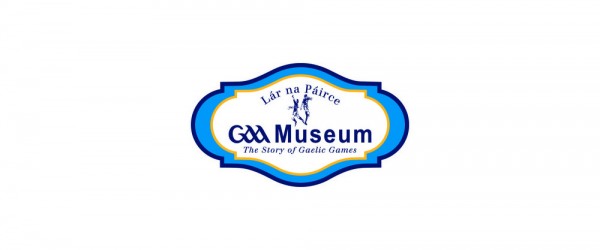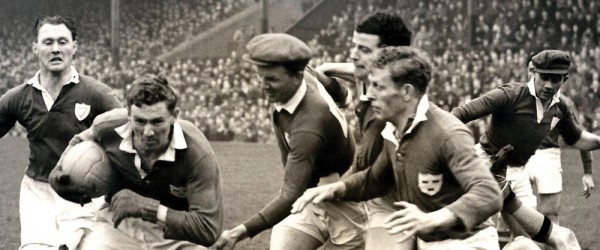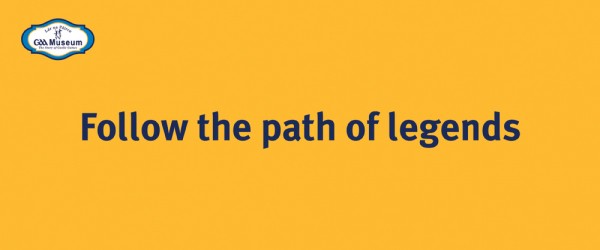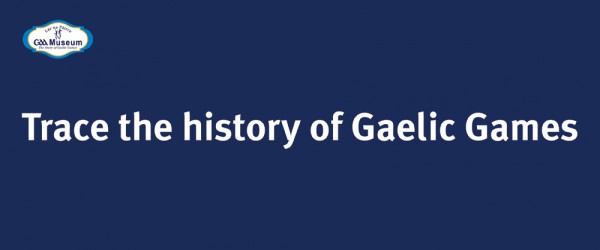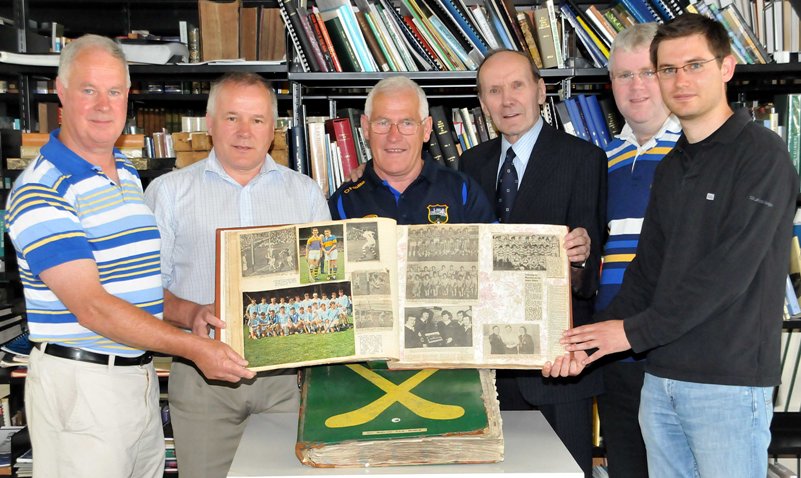The Sam Melbourne G.A.A. Collection
By Seamus J. King
Sam Melbourne died on August 11, 2013 in his ninety-first year. His collection of G.A.A. material forms the basis of Lár na Páirce, the Museum of Gaelic Games at Slievenamon Road, Thurles.
Over eightyty years ago Sam started his collection which includes over 300 hurleys, signed by their star owners, photographs, whistles, jerseys, footballs and sliotars, newspaper cuttings and trophies, all relating to the history and deeds of great hurlers and footballers.
Born in 1923 at Curraheen, Horse & Jockey, Sam was a Church of Ireland man of farming stock whose boyhood heroes were Jack Gleeson and Tim Condon, who won three and four All-Irelands respectively at the turn of the century. Sam himself played hurling with success and was a member of the Mid minor team in 1940 and 1941. Cycling was another important sport for him and he recalls cycling to the 1945 All-Ireland.
His greater claim to fame was his collection of G.A.A. material, which he started in 1937 with Johnny Ryan’s hurley. Johnny and the rest of the famous Moycarkey family were also his heroes.
He continued his collection when he moved into Thurles in 1948 to open a sports shop in Friar Street. The oldest hurley in the collection dates back to Ennis in 1870. According to Sam he never met with a refusal when he asked a player for an item.
John was married to Charlotte Smyth from Killenaule by this stage and they decided to move to Dublin in 1956. His collecting never ceased and over the course of years he had amassed a large amount of material.
Sam entered a new stage of his life after coming to Dublin, Someone suggested he should put the material on show and he jumped at the idea. One of the first places he brought his exhibition was to Ballycotton on the invitation of Jack Lynch and Fr. Bertie Troy. He never looked back after that.
He used load up his collection in a Hiace van on a Friday evening and drive to some G,A,A, club or community centre anywhere in the country, set up his exhibition on Saturday and return home on Sunday evening. He would give a talk, answer all kinds of questions and even add to his collection during the visit. He admits this was a wonderful part of his life and he used to love doing it.
He continued this way of life into the eighties when his collection had grown so large his garage was no longer big enough to contain it. The years were also catching up on Sam and the energy wasn’t as great as previously. He decided to find a new owner for the collection. Eventually the Tipperary county board purchased it from Sam in 1988.
The county board looked around for a location to house the collection and, in conjunction with Thurles Development Association and Shannon Development, the old Bank of Ireland building on Slievenamon Road was purchased, refurbished and opened as a Museum of Gaelic Games by President Mary Robinson on November 8, 1994, one hundred and ten years and a week after the foundation of the G.A.A. in Hayes’s Hotel. It ensured that Sam Melbourne’s collection would continue to be available for viewing by the general public.
The Scrapbook Collection
The Sam Melbourne Collection housed in Lár na Páirce also includes an extensive scrapbook collection that Sam Melbourne put together over forty years. During this period he cut texts and pictures from every newspaper, national and provincial, after every game and painstakingly pasted them into bound volumes, many of which started life as weighty ledgers, wallpaper samples or smaller albums The collection includes a sprinkling of memorabilia from other sports as well as gaelic games, and also pictures of contemporary personalities in other walks of life and the great showbands that filled the ballrooms of romance between the fifties and the eighties..
The total collection comes to thirty-seven items. Twenty-five of these are filled with the memorabilia of hurling and football games that used to cover the walls of the Melbourne garage at Villa Park Gardens off the Navan Road, Dublin until he ran out of space to show them. As he stated in an interview with Sean Cryan in the Sunday Press in 1978: ‘I begged, borrowed and bought pictures anywhere I could lay hands on them and as I ran out of wall space I put them in these albums pointing to huge tomes measuring 3 feet by 2 foot .’ It has been estimated that if all the pages were spread out side by side, and virtually every page is covered on each side, the lot would cover close to 700 square metres. When the amount of cutting and pasting is taken into consideration, the mind boggles!
As well as the scrapbooks devoted to Sam’s collection there are a number of albums belonging to Frank Barrett of Holycross, covering the period 1937-45, apparently scrapbooks kept by Frank during those years and presented to Sam. There is also one attributed to Michael Wall, which covers the so called ‘thunder & lightning final’ of 1939. There are a number of albums devoted to Sam’s personal life. One is devoted to an exhibition of his museum at Na Fianna Club in 1981. Two further albums are devoted to the years 1980 and 1981 and there is also small family album.
There is also a Visitor’s Book which Sam Melbourne had people sign when the visited his museum as he toured around the country. Patricia, Ann, P. J. and Edel Quinn of Screen signed when he visited Wexford. The Doyles of Cornafean turned out in numbers when he visited Co. Cavan. Mary Byrne and Pauline Kelly pf Carrig, Birr also signed the book in Cavan. The museum was in Mullinahone in 1982 when it was signed by Brother Joseph Perkins. The last signatures were written on August 28, 1984 and they include Michael Craddock of Moyne, Co. Tipperary and Anne Marie Craddock, 7 Ellesmoe Avenue, North Circular Road, Dublin 4.
In the Sunday Press article referred to above, Sam Melbourne said about the scrapbooks: ‘Each volume, whether of pictures or newspaper cuttings of every match played anywhere in the last 40 years, has its cover hand-painted with the symbol of the code involved and is tagged chronologically for ready reference.’ Unfortunately, I have been unable to discover the code – maybe we need an Indiana Jones – with the result that it is difficult to discover a sequence in the insertion of the cuttings and pictures. There is no statement at the beginning of a volume that this scrapbook was begun on January 1, 1955 and continued until December 1961.
It appears that many of the volumes have a precise starting point but that there were later insertions. Whereas this can lead to a long search to find something relevant to one’s requirements, it can throw up some very interesting material. One is likely to come across, as well as match reports and pictures of teams and individual players, a great number of poems and ballads that were inspired by club and county victories. One of these caught my fancy. The Gallant Syddan Men, inspired the local poet to put pen to paper after victory in the Meath championship. The wedding photographs of hurling and football stars can be found in abundance. The Sports Stars of the Week are featured regularly. Great sporting icons in other sports such as boxing, Mohammed Ali, wrestlers like Jack Doyle, and golfers like, Joe Carr, are also included. And, as the fifties, sixties and seventies were the era of the great showbands, there are many pictures of these in the volumes.
Many of the team pictures are taken from the newspapers of the time, but there is also quite a spattering of hardcopy photographs. As he stated in the Sean Cryan interview Sam bought a lot of pictures for inclusion and most of these are of fine 10” x 8” size in black and white. Many of these may well be lost by now, which makes their presence in these scrapbooks an important resource.
The scrapbooks have seen a lot of wear and tear as a result of being exhibited regularly. They have suffered from handling but, in general, are in a good state of repair. In some cases the entries have some loose and are in need of remedial work. In other cases they have been the victim of vandalism, with photographs and other entries cut out of the pages. Thankfully there aren’t many such instances.
The period of time covered by the scrapbooks is from the 1940s to the 1990s with the main emphasis on the fifties sixties and seventies. It would appear that Sam became the avid collector of material with Tipperary’s rise to glory with the three-in-a-row senior hurling All-Irelands 1949-1951 but, once the bug got into him, he became a national collector of G.A.A. material. This is reflected in his parting shot to Sean Cryan at the end of the 1978 interview: “Any man from any of the 32 Counties, who comes here and fails to find his county represented in some way or other can have the lot.’
This wonderful collection of material is a fine tribute to the enthusiasm and dedicated effort of Sam Melbourne over many decades. All the artifacts he collected are on display in Lár na Páirce, the Museum of Gaelic Games on Slievenamon Road, Thurles, while his great scrapbook collection may be consulted in the Source, Thurles, where the Local Studies section of Tipperary County Library is located.
Lár na Páirce
Museum of the GAA and Gaelic Games
